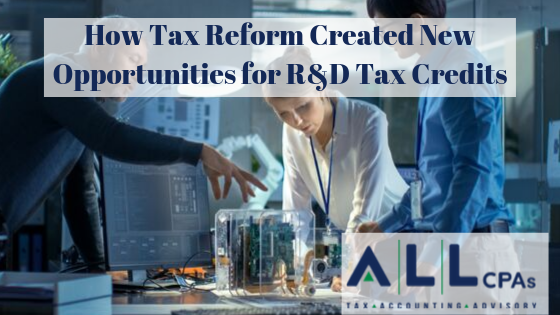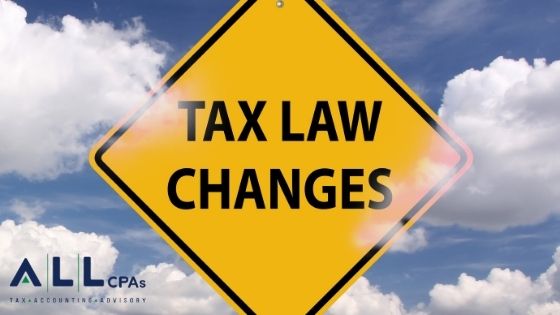
By Christopher Underwood, CPA, MST
Taypayers everywhere were significantly impacted by the 2017 Tax Cuts and Jobs Act (TCJA). In particular, the Act impacted research and development (R&D) tax credits and deductions in ways large and small. The following summarizes the key changes to R&D tax credits in the wake of tax reform and offers takeaways for how these may affect you or your business.
Background
The Research and Experimentation (R&E) tax credit was first introduced in 1981 as a two-year incentive with the goal of increasing investments in research and development activities in the U.S. It was then made a permanent part of the Internal Revenue Code in 2015 under the Protecting Americans against Tax Hikes Act (PATH Act). Part of this credit is IRC Section 280C(c), which prevents taxpayers from receiving a double benefit for research-related expenses. Specifically, taxpayers must either reduce ordinary deductions by the amount of the credit or elect a reduced credit generally equal to the tax-effected amount of the research credit. As an alternative to the credit, IRC Section 174(a) provides immediate expensing of R&D expenditures and IRC Section 174(b) provides an election to amortize these costs over a period of not less than 60 months. Software development was included in such R&D expenditures under Rev. Proc. 2000-50.
Changes Affecting the R&D Tax Credit
One of the most significant changes of the TCJA was the reduction in the corporate income tax rate to a flat 21 percent from the top rate of 35 percent. Because Sec. 280C(c) requires taxpayers to reduce the amount of the R&D credit by the maximum tax rates, corporations can now benefit from an enhanced deduction. Whereas taxpayers previously only recognized a net benefit from this credit of 65 percent, the benefit has now increased to 79 percent.
Additionally, the TCJA repealed the corporate alternative minimum tax (AMT) and increased the exemption and phase-out amounts for individual AMT. Historically, the R&D tax credit could only be used to offset federal income tax liabilities and not AMT liabilities; eligible small businesses were already exempt from this provision. These credits can now be used to offset AMT in addition to federal income tax. However, corporate taxpayers are still subjected to IRC Section 38(c) which specifies “…a credit cannot exceed the excess of the taxpayer’s net income over 25 percent of the taxpayer’s net regular tax liability above $25,000.” For passthrough entities, more individuals will now be able to recognize a benefit from such credits as fewer individual taxpayers will be subject to the AMT provisions.
Another change comes in the form of net operating loss (NOL) deduction reform. Previously, a taxpayer could offset 100 percent of taxable income through utilization of NOLs. For tax years beginning after Dec. 31, 2021, NOLs can only be used to offset 80 percent of taxable income. This could enhance the need for the R&D tax credit to further offset any remaining tax liability. NOLs generated prior to 2018 are grandfathered in under the old law and can still be used to offset 100 percent of taxable income.
Changes Affecting Section 174
As previously mentioned, provisions under Section 174 permit taxpayers to immediately expense R&D expenditures, including software development. For tax years beginning after Dec. 31, 2021, this option is eliminated. Instead, taxpayers will be required to capitalize and amortize such expenses over a five-year period beginning with the midpoint of the tax year in which such expenditures are paid or incurred. This period is increased to 15 years for research expenditures conducted outside the U.S. Furthermore, the enhanced language under the provisions will now include software development as a specified research or experimental expenditure, thus eliminating the reliance on Rev. Proc. 2000-50. Taxpayers currently deducting such expenses will be required to file a Form 3115, Application for Change in Method of Accounting, to begin amortizing such expenses. This change is applied on a cutoff basis, eliminating a Section 481(a) adjustment.
Planning Opportunities
Taxpayers now have some interesting planning opportunities to maximize the benefit of research and experimental expenditures. With the elimination of the AMT provisions and changes to the NOL deductions, more taxpayers may realize benefits from the research tax credit. To generate the greatest benefit, taxpayers may seek to expedite R&D expenditures before the Section 174 changes are implemented in 2022. The ability to expense these as incurred is available only until Dec. 31, 2021. Additionally, due to the longer amortization period, taxpayers should also evaluate the location of future R&D activities. For individual taxpayers, the Section 174 changes may be more beneficial. The capitalization requirements would increase qualified business income, which would also increase the Section 199A qualified business income deduction available to individual taxpayers. Although the top income tax rate is at 37 percent, the individual tax rates are not permanent like the corporate tax rate. If the rates revert to pre-2018 rates, individuals would recognize a higher tax benefit from the amortization of such expenses rather than expensing them currently.
Key Takeaways
- The credit is more valuable now that the tax rates have decreased.
- The credit can now be used to offset AMT. With the elimination of corporate AMT and increased limits for individuals, the credit is now more valuable to more types of taxpayers.
- NOL deductions can only offset up to 80 percent of taxable income, so this credit could provide additional tax shields.
Now is the time to analyze current research expenditures and devise a plan to maximize tax benefits going forward for all types of taxpayers.
Do you have questions about the R&D tax credit or other tax planning issues? Please contact me at cunderwood@all-cpas.com or 617-738-5200.
About the Author
Christopher Underwood, CPA, MST
Christopher Underwood, CPA, MST, has over 10 years of experience servicing the accounting and tax needs of individuals, trusts, estates, and privately held businesses. He works with clients across a broad range of industries, including aerospace, commercial cleaning, wholesale distribution, manufacturing, healthcare, professional services.
Chris has a passion for real estate tax and helping his clients achieve their long-term real estate investment goals. He likes to take a holistic approach to engagements and help his clients get to where they want to be in the short-term and in 5 or 10 years from now.
Recent Articles
Rising Construction Costs from COVID-19 Lead to New Bidding Approaches
Like other essential industries, t [...]
Nexus Requires Compliance and Begins by Filing Tax Returns
“Nexus” may sound like the name of [...]
The Impact You May See from the Build Back Better Act’s Tax Changes
The Build Back Better Act came und [...]





